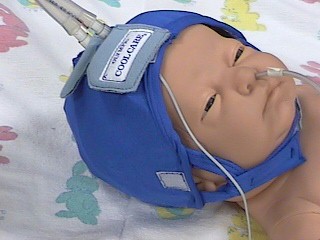
Researchers are studying whether devices such as this cooling cap can limit brain damage in newborns caused by asphyxiation.
Treatment may cool asphyxiation's impact on newborns' brains
Their numbers may be small, but for that one baby out of every 1,000 who suffers from brain damage due to lack of blood flow or lack of oxygen during birth, the effects can be enormous.
Vanderbilt University Medical Center is one of 29 centers in five countries that will study a method of cooling the brains of infants born asphyxiated to reduce brain damage.
The randomized study is expected to enroll 265 babies over the next one to two years. Vanderbilt has already enrolled two babies in the study and is expected to contribute four infants each year to the overall study. Half of the babies enrolled will receive the cooling treatment. Half will not.
The premise, based on success in animal studies, is to see whether cooling the newborn brain prevents further brain damage in babies deprived of oxygen at birth. Many of these babies develop cerebral palsy or mental retardation due to the lack of oxygen.
The lack of oxygen can result from many causes but most usually from when there is placental abruption; when the cord comes first in delivery and the blood flow and oxygen are cut off by the baby's head; or when the uterus ruptures and the baby is born into the abdominal cavity of the mother.
The study utilizes a "cooling cap," a three-piece cap in which water is circulated through two hoses in the shower-cap-like portion of the cap next to the head. The brain is kept at 85° Fahrenheit and the rectal temperature at 94°, instead of the normal body temperature of 98.6°. The middle portion is similar to a bathing cap, holding the lower portion snug against the baby's head. The outermost cap is made of an insulating material.
The caps are left on the babies' heads for 72 hours, a period of time deemed optimal by animal studies. The babies randomized into the group who don't receive treatment will receive routine care.
When brain cells die, scientists believe there is a chemical reaction of sorts, explained Dr. William F. Walsh, professor of Pediatrics and Chief of Nurseries at Vanderbilt University Medical Center.
"If you cut off the blood flow for a half hour in animals and look at the brain, you'll see that about 10 percent of cells are dead. But if you look at it three hours later, it will be 30 percent and six hours later, 90 percent. When a cell dies, it essentially releases poisons. All the contents of the cell start affecting the cells next to it. It's almost a domino effect or a chain reaction of cell injury."
Calming the chemical reactions with cold is like cooking, Walsh said.
"If you keep them cold, they either don't do anything or they go very slowly. That's the theory — if you can make these chain reactions stop, the brain injury may be limited."
Walsh said that cooling baby's heads goes against everything neonatologists have been taught.
"Since 1958 we have known that babies do better if kept warm. We have isolettes, radiant warmers and every mechanism in the world to keep babies toasty. This is a foreign concept, to let them get cold."
Time is critical in enrolling babies in the study, Walsh said.
Animal research has shown that the treatment has no effect if begun after six hours, so the study requires the infants be enrolled no later than 5 hours after birth.
Walsh is trying to get the word out to community pediatricians about the study. "It's essential for physicians to recognize the baby is in trouble quickly because they've only got five hours to get them here."
The closer the infant lives to Nashville the better the chance for the infant being enrolled in the study. One of the babies who participated in the study was from Bowling Green, Ky., the other from Shelbyville. Vanderbilt's neonatal emergency transport vehicle – the Angel Van – will pick up the infants who live close enough and bring them to Vanderbilt.
"But there is more benefit to the child if the treatment is begun sooner rather than later. The quicker you cool them, the more brain protection there is. Time is a crucial element in this study."
Because of the potential risks of cooling a baby, the babies must also be considered sick enough to take the risk, Walsh said. They must have at least an 80 percent chance of having some brain damage from the birth trauma; still have trouble breathing 10 minutes after birth; and have an abnormal EEG.
"They must be at high risk because this treatment is somewhat risky. And the family must be willing to participate whether their child will be cooled or whether they won't. That's hard to do. I have to tell the families I think this might be helpful. That's why we're participating in the study. Yet it might be dangerous to the baby to be cold. The only way we can do this is as a randomized study. Later, if it works, we can cool the heads of every baby who meets these criteria."
The final outcome of the success of this treatment will be determined by a test given to the participating infants at 18 months of age. The test, the Bayley Scale, is an IQ marker designed for toddlers. The toddlers will also be examined to see if they are walking and talking.
"The animal data is very encouraging," Walsh said. "We know it's a practical thing that can be done. Whether it will help these babies is what we're trying to discover."
Now that neonatologists have improved lung care in premature babies, there is more research on brain development and brain function, Walsh said.
"We're no longer just trying to keep them alive. We're trying to deliver normal, healthy children."













